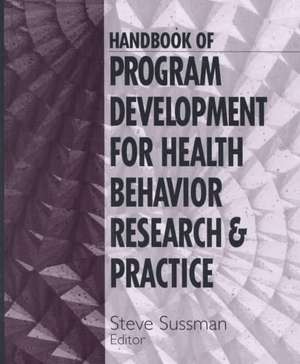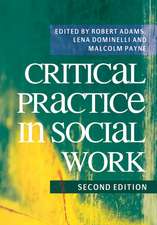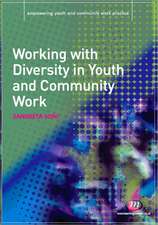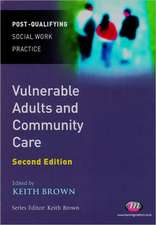Handbook of Program Development for Health Behavior Research and Practice
Editat de Steven Yale Sussmanen Limba Engleză Hardback – 20 dec 2000
Preț: 1031.52 lei
Preț vechi: 1085.81 lei
-5% Nou
Puncte Express: 1547
Preț estimativ în valută:
197.39€ • 207.03$ • 164.32£
197.39€ • 207.03$ • 164.32£
Carte tipărită la comandă
Livrare economică 01-15 aprilie
Preluare comenzi: 021 569.72.76
Specificații
ISBN-13: 9780761916734
ISBN-10: 0761916733
Pagini: 584
Dimensiuni: 187 x 232 x 37 mm
Greutate: 1.12 kg
Ediția:New.
Editura: SAGE Publications
Colecția Sage Publications, Inc
Locul publicării:Thousand Oaks, United States
ISBN-10: 0761916733
Pagini: 584
Dimensiuni: 187 x 232 x 37 mm
Greutate: 1.12 kg
Ediția:New.
Editura: SAGE Publications
Colecția Sage Publications, Inc
Locul publicării:Thousand Oaks, United States
Recenzii
"Steve Sussman and his collaborators have done a magnificent job of putting this book together. It is clearly going to be an important resource for health education researchers for years to come. There are many social science and biomedical researchers who have not been trained in the methods of health education research who will benefit from the wisdom and know-how contained in this volume. There are also many students in schools of public health, nursing, education and communication whose career goal for research or practice in health education and promotion will be assisted greatly."
Cuprins
PART ONE: RATIONALE FOR A HANDBOOK OF PROGRAM DEVELOPMENT
Rationale for Program Development Methods - Steve Sussman and Thomas Ashby Wills
Case Study 1 - John K Worden
Implementing Program Development in a State or Local Health Department: A Smoking Prevention Media Campaign Example
Identifying and Overcoming Barriers to Emirically Based Health Behavior Program Planning - Rick Petosa
PART TWO: THE CONNECTION BETWEEN THEORY AND ACTIVITY POOLING
Praxis in Health Behavior Program Development - Steve Sussman and Alan N Sussman
Case Study 2 - Alan W Stacey and Susan L Ames
Implict Cogition Theory in Drug Use and Driving-Under-the-Influence Interventions
Choosing Assessment Studies to Clarify Theory-Based Program Ideas - Valerie Johnson and Robert J Pandina
Pooling Information about Prior Interventions - Carol N D'Onfrio
A New Program Planning Tool
Case Study 3 - Starr Niego and James Peterson
The Program Archive on Sexuality, Health and Adolescence (PASHA): A Study of Activity Warehousing
PART THREE: PERCEIVED EFFICACY METHODS
Verbal Methods in Perceived Efficacy Work - Guadalype X Ayala and John P Elder
Case Study 4 - Steve Sussman, Kara Lichtman and Clyde W Dent
Use of Focus Groups for Adolescent Tobacoo Use Cessation
Non-Verbal Methods of Perceived Efficacy - Elahe Nezami , Gerald C Davison and Beth R Hoffman
Case Study 5 - Clyde W Dent, Kara Lichtman and Steve Sussman
Use of a Theme Study for Adolesecent Tobacco Use Cessation
PART FOUR: IMMEDIATE IMPACT METHODS AND PROGRAM CONSTRUCTION
Component Studies - Thomas R Simon, Kris Bosworth and Jennifer B Unger
Case Study 6 - Kara Lichtman et al
Project EX Component Study
Sequencing Issues in Health Behavior Program Development - William B Hansen and David G Altman
Pilot Studies - Michael Linskey and Steve Sussman
Case Study 7 - Louise Ann Rohrbach et al
Development and Pilot Testing of Project SMART
PART FIVE: TRYING IMMEDIATE OUTCOMES MEASURES TO LONGER-TERM OUTCOMES AND CONCLUSIONS
Using Meta-Analyses to Improve the Design of Interventions - Stewart I Donaldson et al
Mediator and Moderator Analysis in Program Development - Stewart I Donaldson
Needs for the Future of Program Development - Steve Sussman, Rick Petosa and Howard Leventhal
Rationale for Program Development Methods - Steve Sussman and Thomas Ashby Wills
Case Study 1 - John K Worden
Implementing Program Development in a State or Local Health Department: A Smoking Prevention Media Campaign Example
Identifying and Overcoming Barriers to Emirically Based Health Behavior Program Planning - Rick Petosa
PART TWO: THE CONNECTION BETWEEN THEORY AND ACTIVITY POOLING
Praxis in Health Behavior Program Development - Steve Sussman and Alan N Sussman
Case Study 2 - Alan W Stacey and Susan L Ames
Implict Cogition Theory in Drug Use and Driving-Under-the-Influence Interventions
Choosing Assessment Studies to Clarify Theory-Based Program Ideas - Valerie Johnson and Robert J Pandina
Pooling Information about Prior Interventions - Carol N D'Onfrio
A New Program Planning Tool
Case Study 3 - Starr Niego and James Peterson
The Program Archive on Sexuality, Health and Adolescence (PASHA): A Study of Activity Warehousing
PART THREE: PERCEIVED EFFICACY METHODS
Verbal Methods in Perceived Efficacy Work - Guadalype X Ayala and John P Elder
Case Study 4 - Steve Sussman, Kara Lichtman and Clyde W Dent
Use of Focus Groups for Adolescent Tobacoo Use Cessation
Non-Verbal Methods of Perceived Efficacy - Elahe Nezami , Gerald C Davison and Beth R Hoffman
Case Study 5 - Clyde W Dent, Kara Lichtman and Steve Sussman
Use of a Theme Study for Adolesecent Tobacco Use Cessation
PART FOUR: IMMEDIATE IMPACT METHODS AND PROGRAM CONSTRUCTION
Component Studies - Thomas R Simon, Kris Bosworth and Jennifer B Unger
Case Study 6 - Kara Lichtman et al
Project EX Component Study
Sequencing Issues in Health Behavior Program Development - William B Hansen and David G Altman
Pilot Studies - Michael Linskey and Steve Sussman
Case Study 7 - Louise Ann Rohrbach et al
Development and Pilot Testing of Project SMART
PART FIVE: TRYING IMMEDIATE OUTCOMES MEASURES TO LONGER-TERM OUTCOMES AND CONCLUSIONS
Using Meta-Analyses to Improve the Design of Interventions - Stewart I Donaldson et al
Mediator and Moderator Analysis in Program Development - Stewart I Donaldson
Needs for the Future of Program Development - Steve Sussman, Rick Petosa and Howard Leventhal
Descriere
This book is intended to take the reader from program development theory through program activity analysis and selection, to immediate impact studies, and intermediate and long-term program outcome measurement. It contains thirteen chapters devoted to substantive techniques with seven case study chapters that demonstrate the use of these techniques in action. Each of these substantive chapters is followed by one or two commentaries by leaders in the field that offer additional considerations for researchers and practitioners.













